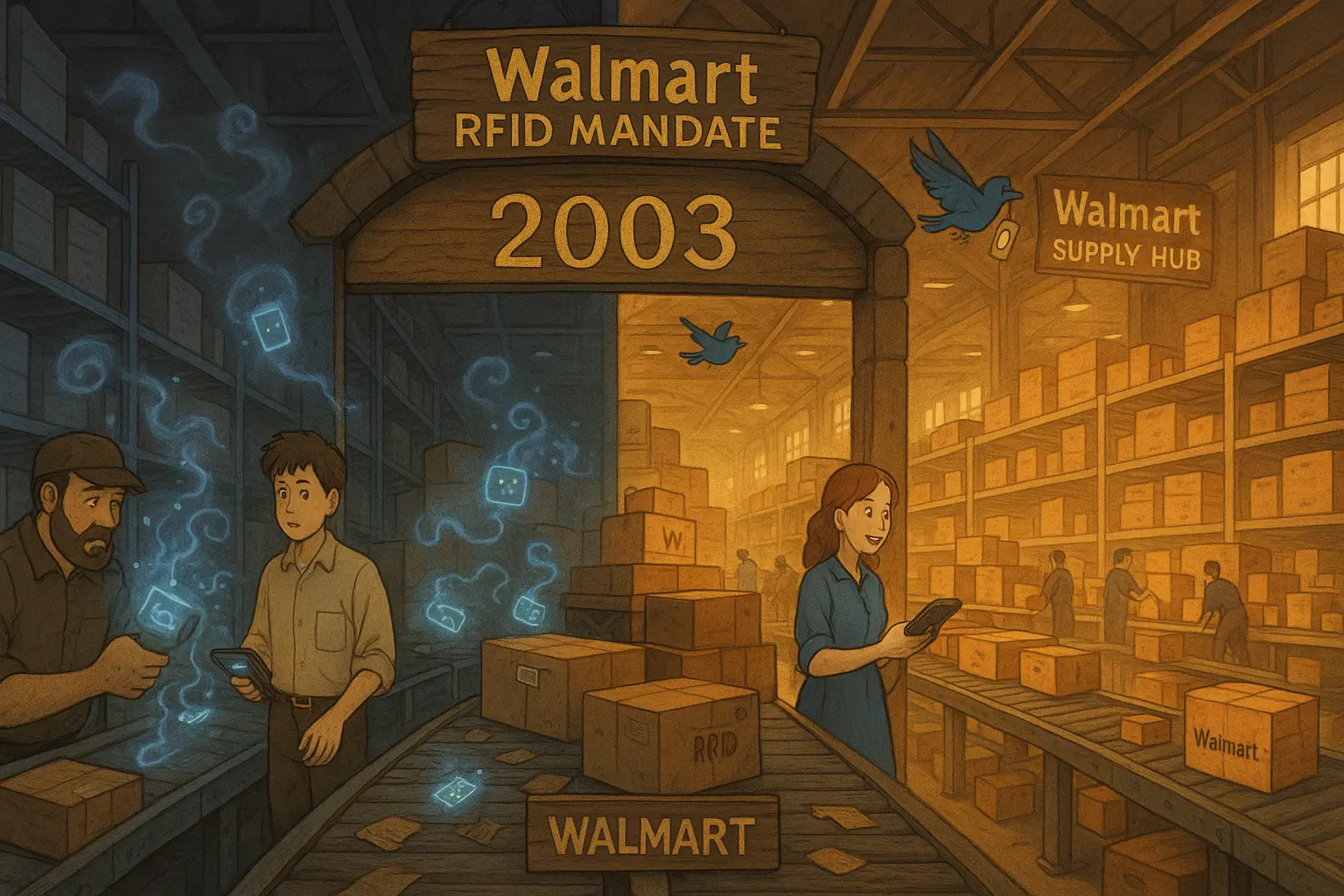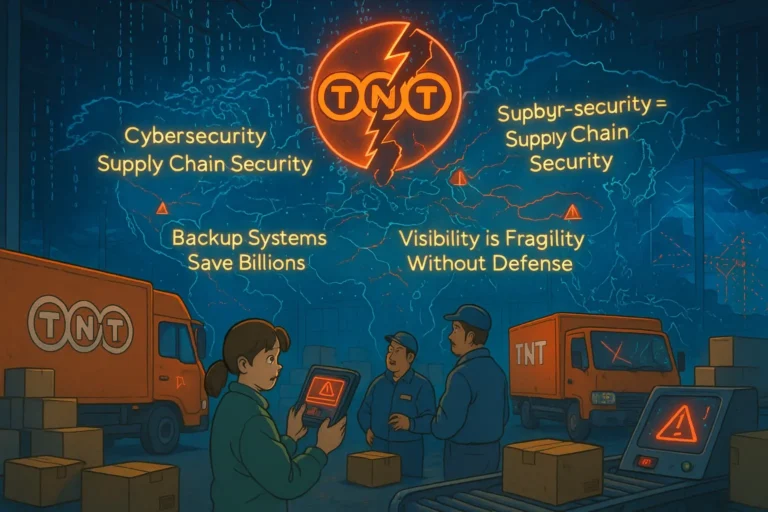
Walmart’s RFID mandate
Walmart’s RFID mandate to its top 100 suppliers in June 2003 challenged the notion that barcodes, combined with labor, were sufficient for better inventory tracking. Walmart bet early on RFID to reduce stockouts and increase visibility into backroom inventory with real-time data.
Article Brief & Key Nuggets:
- Walmart used RFID to attack stockouts, data blind spots, and slow replenishment.
- Phased pilots, clear deadlines, selective penalties, and strong partner support (including standards, training, and infrastructure) pushed suppliers to comply.
- The result was 16% fewer out-of-stocks, 3 times faster shelf replenishment, and fewer manual orders, thanks to cleaner system signals.
- The first rollout stalled over tag costs, tech readiness, and unclear supplier ROI—then rebounded when item-level RFID and omnichannel made accuracy essential.
- The key takeaways are: start narrow, align incentives, support your partners, and scale only when costs and technical maturity ensure a positive return on investment.
- African supply chains can apply the model with targeted pilots, shared infrastructure, and standards tailored to local market constraints.
Walmart Needed To Fix Stockouts and Unlock Visibility
At the turn of the century, Walmart had a problem. Average store stockouts reached nearly 7%, with high-demand items peaking at around 17%. Ultimately, the situation was driving lost sales and frustration.
As a solution, Walmart pushed the RFID (radio-frequency identification) mandate on suppliers in 2003 with a large-scale rollout scheduled for 2005. The RFID mandate was meant to address the chronic inventory errors and empty shelves.
RFID promised real-time visibility that barcodes couldn’t match: instead of line-of-sight scans of each case, tags could be read wirelessly and automatically as goods moved through DCs and into stores.
With clearer signals, such as which products were in the backroom and which were on the way, Walmart could streamline its inventory receiving process, automate counts, and expedite replenishment.
On paper, the plan was so promising that analysts projected annual savings of up to $8.4 billion once RFID was fully deployed. The savings they noted were going to be driven by lower scan labor costs, fewer errors, reduced shrinkage, and improved on-shelf availability.
Walmart’s RFID mandate also aligned with its long-term tech plan, utilizing the MIT Auto-ID Center’s EPC standards—an early path to “smart shelves” that detect low stock and trigger reorders.
Tags weren’t yet affordable enough for every item, but starting at the pallet and case levels allowed Walmart to capture immediate efficiency and sales gains while the technology matured.
In short, the mandate aimed to address inventory inaccuracy and stockouts by providing better signals, thereby creating a leaner and more responsive supply chain.
“An RFID-tagged item made it to the shelf three times quicker than a non-tagged item,” said Simon Langford, Walmart’s RFID strategy manager. In retail language, faster restock meant fewer empty shelves.
Read more: Why The $4B H&M’s Inventory Failure Happened.
Phasing and Enforcement Of The RFID Mandate
Walmart paired the RFID mandate with simple pilots, infrastructure, and the weight of its volume.
After briefing suppliers in 2003, the company ran a Texas pilot in 2004 with eight major brands feeding tagged cases into one DC and seven stores. The January 2005 go-live pulled in the top 100, and the “next 200” were set for 2006 as readers rolled into DCs and hundreds of stores.
Enforcement mixed clear deadlines with implied penalties. For example, it signaled fines for non‑compliance, and Sam’s Club later applied per‑pallet service fees when tags were missing.
For many suppliers, this was no idle threat – given Walmart’s significance (some companies depended on Walmart for 10–40% of their sales.
According to the company’s CIO at the time, Linda Dillman, “there is conclusive evidence RFID increases the frequency with which we can put products in customers’ hands.”
In other words, it helped ensure that if the product were in the building, it wouldn’t languish unseen in the back – it would get to the shelf where customers could buy it.
But beyond the threat of fines, Walmart also hosted summits and shared standards to reduce trial-and-error in tag placement, data formats, and read quality.
The Impact of Walmart’s RFID Mandate
Walmart’s early RFID rollout didn’t fully meet the loftiest expectations, but it delivered measurable gains, advanced technology standards, and reshaped retailers’ thinking about inventory accuracy.
Key Impacts on inventory tracking and supply chain
1. Fewer Stockouts, Faster Replenishment
A University of Arkansas study (2005) found RFID-enabled stores had 16% fewer out-of-stock items than control stores. Tagged products were replenished 3× faster because RFID pinpointed backroom inventory ready to go to shelves. The RFID stores were 63% more effective at replenishing stockouts than non-RFID stores, resulting in fewer lost sales.
2. Improved Inventory Accuracy and Visibility
Real-time scans at receiving docks and storage areas tracked products from arrival to shelf, which reduced misplaced inventory. If the product was in the building, RFID helped ensure it reached the sales floor. More accurate perpetual inventory records supported better decision-making and planning.
3. Faster, Leaner Operations
Manual store orders dropped by 10% as automated replenishment became more reliable. The strategies also reduced excess inventory and carrying costs by improving order precision. Early trials with RFID-enabled advanced ship notices and temperature monitoring showed potential for broader supply chain optimization.
4. Industry Standards and Cost Reduction
Walmart’s mandate accelerated the adoption of the EPCglobal Gen2 UHF RFID standard. Scale drove down tag costs from $0.50 in 2003 to 3–5 cents by the early 2020s, which in turn encouraged adoption by other major players (e.g., DoD, Target, Best Buy), creating a network effect that boosted RFID’s value.
5. Long-Term Transformation
Although the 2005–2007 push slowed, it laid the groundwork for item-level RFID—now a cornerstone of omnichannel retail. Modern implementations achieve 97%+ inventory accuracy, which is essential for services like BOPIS (buy online, pick up in-store) and shifted the mindset from periodic manual counts to continuous, automated inventory tracking as a strategic capability.
Read more: Lessons From McDonald’s & Yum Brands’ Expired Meat Disaster in China.
Challenges and Hiccups with Walmart’s RFID Mandate
Despite the early impacts, progress slowed when costs and tech lagged. Implementing RFID at Walmart’s scale came with real hurdles that cooled early enthusiasm:
1. High Tag Costs
In 2003–2005, tags cost about $0.40–$1.00 each. Walmart didn’t subsidize them, so suppliers ate the cost, which was tough for low-margin goods. Prices didn’t fall to single-digit cents until the 2010s.
2. Technical Limitations
Early UHF standards (EPC Class 1, Gen 1, then Gen 2) had quirks. Liquids absorbed signals, and metals reflected them, creating dead spots and false readings.
Teams had to test tag placement and pallet builds, which was extra work and manpower. You couldn’t just slap on a tag and expect 100% dock-door reads.
3. Data and Integration Challenges
Reading tags was easy. Using the data was hard. EPCs had to be linked to product records, systems needed upgrades, and middleware had to filter out duplicates and errors.
With barcodes and RFID running in parallel, many suppliers adopted a “slap-and-ship” approach to meet the mandate, thereby limiting their own gains.
4. Mixed Supplier Adoption
Deadlines slipped. By January 2005, only about half of the top 100 suppliers were consistently tagged; the next 200 largely lagged behind by January 2006.
Smaller firms lacked capital and skills; larger ones waited for clear ROI. The share of RFID-tracked inventory stayed lower than planned, muting network effects.
5. Internal Hurdles and Leadership Changes
Momentum dipped after CIO Linda Dillman assumed a new role in 2006. Her successor, Rollin Ford, took a lower-profile approach. A February 2007 Wall Street Journal piece stated that the push was “fizzling,” citing unclear value for many suppliers.
Walmart disputed the assessment, but the slowdown was evident nonetheless.
6. Strategy Pivot
In late 2007, Walmart narrowed its scope. It focused on Sam’s Club, promo displays, and select item-level pilots where the case was stronger.
By early 2009, plans for chain-wide pallet and item-level tagging were on hold, and Procter & Gamble ended its display pilot because the data wasn’t improving execution. The first chapter closed quietly rather than on the original timeline.
Read more: Starbucks’ Ethically Sourced Coffee: Behind The Scenes.
Lessons From Walmart’s RFID Mandate
Walmart’s experience with RFID between 2003 and 2006 offers valuable lessons for teams, suppliers, and any supply chain aiming to innovate in operations. Key takeaways include:
1. Timing Matters
It is essential to resist hype and scale only when returns are proven. Push hard when tech and cost align with payback. And deploy when unit economics support reliable reads and clear ROI.
For instance, the 2003 push outran tag price declines and read reliability. But the mandate was revisited in 2022, and this time, it relied on affordable tags, stricter standards, and urgent omnichannel needs.
2. Align Incentives
Make value visible to suppliers, not just retailers. It is essential to share the value story and demonstrate it through pilots. Compliance sticks when suppliers see a sales lift or labor savings.
3. Start Focused
Select categories with pain points, readable packaging, and quick wins. And target cases where physics and upside favor success.
Apparel sales were successful thanks to labels, packaging, and high on-hand inventory. Promotional displays and select categories proved value before scale. Use a thin wedge to earn trust and budget.
4. Support the Network
Train, standardize, and reduce friction. Big mandates are effective when partners receive playbooks and tools. Build a service stack that shrinks trial time and integration risk.
In Walmart’s case, the company improved with supplier sessions, EPC standards, tag placement guidance, and infrastructure investment. Build a service stack that shrinks trial time and integration risk.
5. Measure Real Outcomes
Stockouts, time-to-shelf, and order quality. Track operational wins that convert to sales and labor savings. Walmart saw 16% fewer stockouts, 3× faster replenishment, and fewer manual orders. Build dashboards around these measures and tie wins to replenishment logic.
6. Stay Persistent
Pause, refocus, then return when conditions improve. Long-cycle bets need patience, data, and staged returns. Walmart paused broad pallet tagging, focusing on select uses, and later reintroduced item-level tagging. Treat setbacks as design input, not the end
One analyst called RFID’s arc “universal hype to an inevitable fizzle to a pandemic-triggered renaissance.” The ultimate lesson: persistence outlasts early-cycle noise.
How African Supply Chains Can Apply These Lessons
When integrating tech solutions or innovating, African supply chains can do the following:
1. Focus The Scope and Standardize Early
Narrow the field and lock basic standards before expansion. Publish simple specs, data rules, and process steps to cut confusion and raise repeatability for execution.
2. Align Incentives Across Partners
Make value visible to every partner to speed adoption. Share gains, remove friction on onboarding, and link compliance to tangible perks like faster receiving or preferred slots for motivation.
3. Build Enablement, Not Just Mandates
Pair deadlines with training, templates, and tools for performance. Run workshops, share placement or setup guides, and provide support channels to shrink trial time for teams.
4. Measure the Few Outcomes That Pay The Bills
Track outcomes that map straight to cash and service. Use a concise scoreboard to track availability, time-to-shelf, on-hand variance, and manual order rate, driving action.
5. Gate Growth by Readiness, not Calendar
Scale only when pilots hit defined bars for accuracy, stability, and labor time. Move in waves once readouts meet targets and SOPs hold steady across sites for reliability.
6. Persist Through Stalls and Return When Timing Improves
Pause when economies are weak and resume when tech, price, and need align. Treat setbacks as design input and keep the play alive for future scale.

Obinabo Tochukwu Tabansi is a supply chain digital writer (Content writer & Ghostwriter) helping professionals and business owners across Africa learn from real-world supply chain wins and setbacks and apply proven strategies to their own operations. He also crafts social content for logistics and supply chain companies, turning their solutions and insights into engaging posts that drive visibility and trust.







